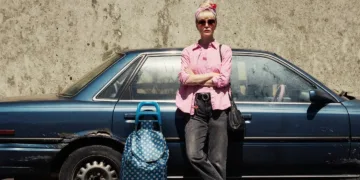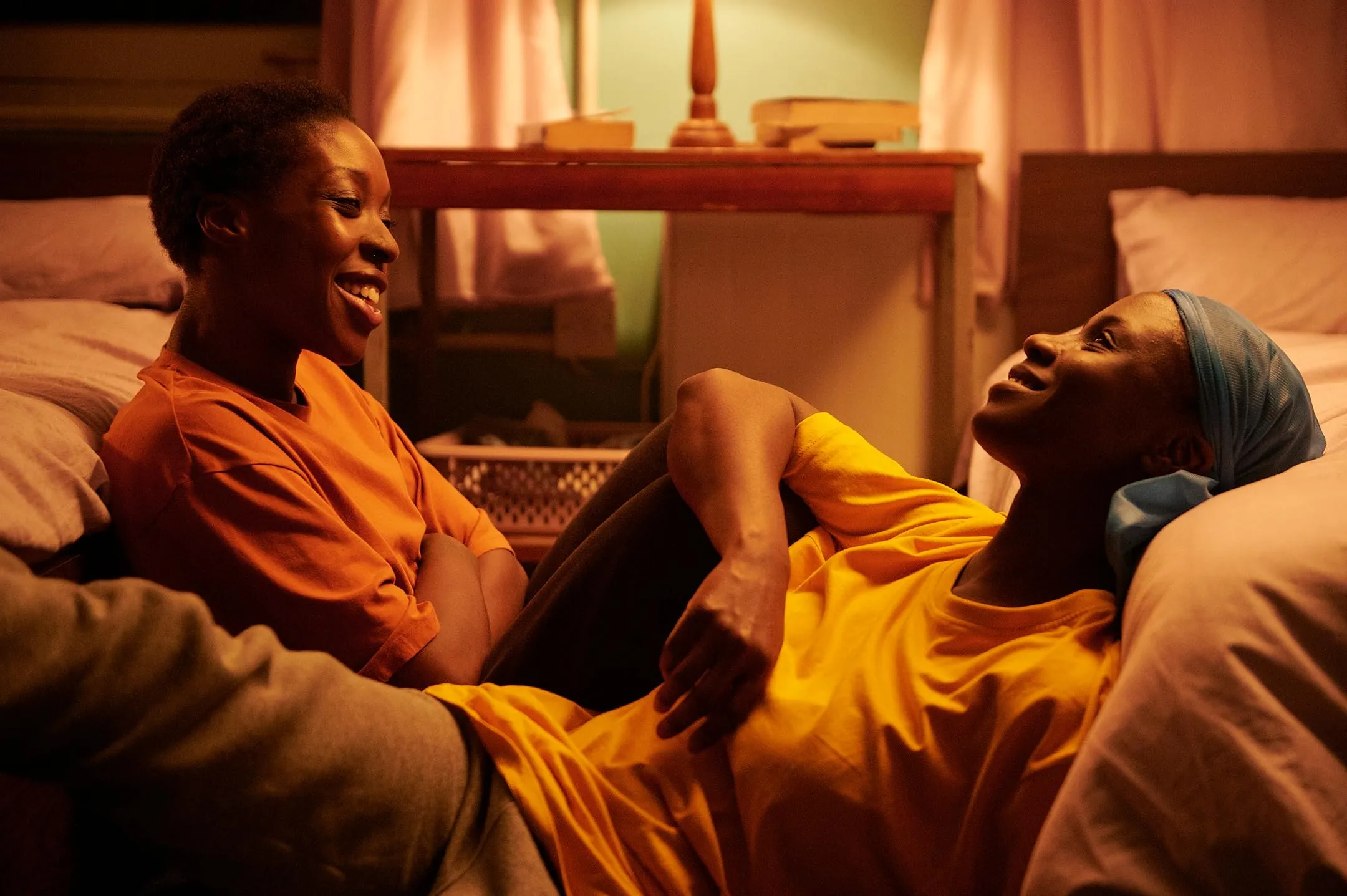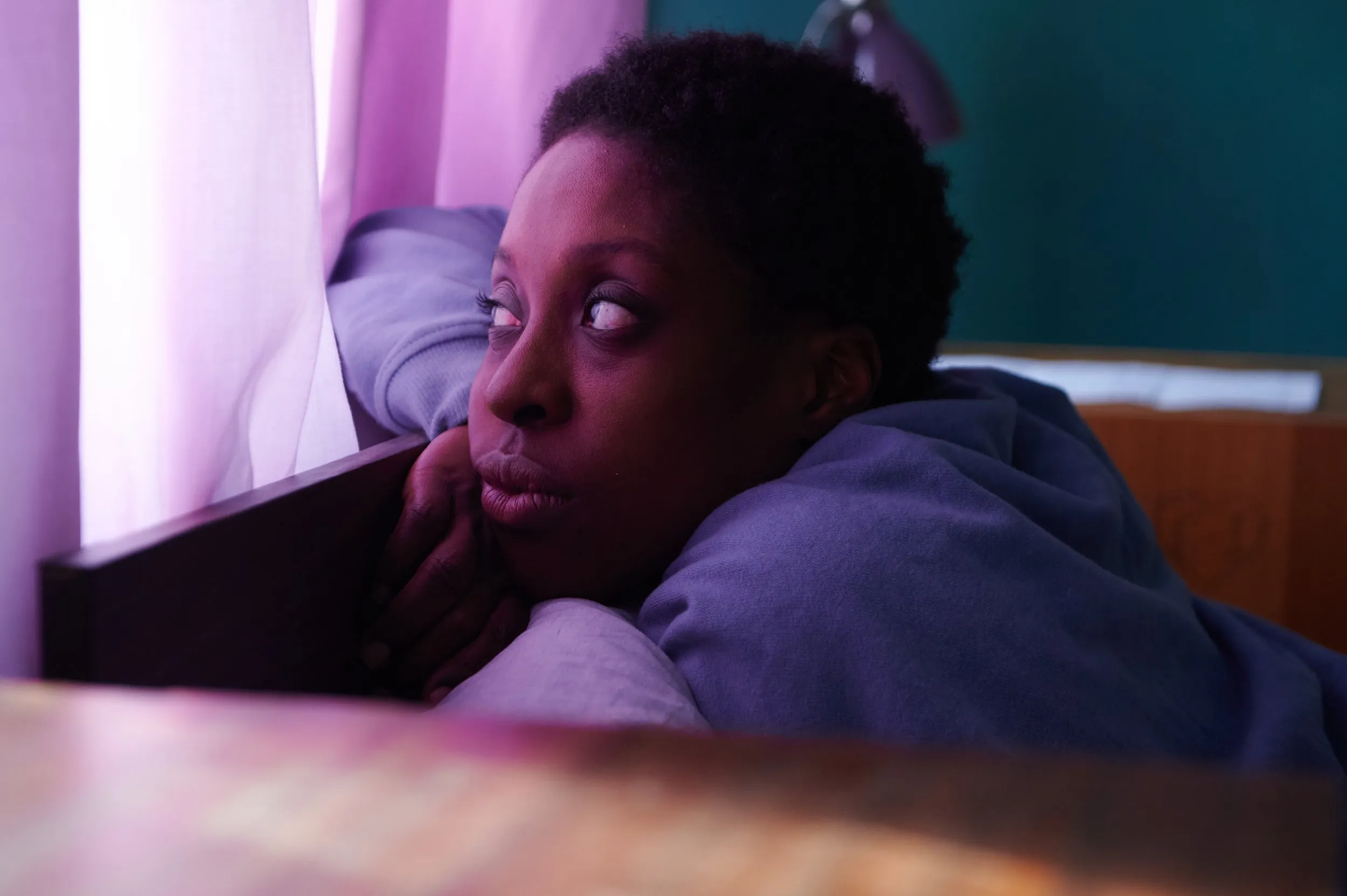Joy Gharoro-Akpojotor’s Dreamers marks a poignant debut, navigating the intimate, complex terrain of asylum seekers in the UK. At its heart is Isio, a Nigerian migrant whose arrival at a British detention center sets the stage for a character-driven exploration of survival, resilience, and love. From the very first moments, Gharoro-Akpojotor subverts the expectations of a political thriller by grounding her story in personal experience, crafting an emotionally potent narrative that defies the stereotypical portrayal of migrants as faceless statistics.
The film’s narrative structure is modest yet effective, relying on quiet moments of human connection rather than grand plot twists. Gharoro-Akpojotor wisely avoids the trap of portraying her characters as mere victims of circumstance, instead allowing the story to unfold through their small, intimate acts of defiance and hope.
Isio’s journey from fear and isolation to a newfound connection with Farah, her roommate and love interest, is handled with a gentle, evolving tenderness that allows the audience to see her not just as a refugee but as a fully realized person with agency.
While the central plot revolves around Isio’s quest for asylum, Gharoro-Akpojotor’s choice to focus on personal relationships—particularly the deep bond that forms between Isio and Farah—provides the emotional core of the film. The narrative unfolds in a series of reflective, almost contemplative moments that feel as though time itself is suspended within the confines of the detention center. The pacing, while at times languid, mirrors the stagnation of Isio’s life in this bureaucratic purgatory, amplifying the tension without the need for overt drama. It’s a storytelling choice that prioritizes nuance over spectacle and depth over fast-paced action.
Character Development and Performances in Dreamers
The character-driven narrative of Dreamers hinges on its portrayal of Isio, played by Ronkẹ Adékoluëjo, whose growth from a fearful, isolated migrant into a person capable of forming connections is the heart of the film. From her initial arrival at the detention center, Isio is emotionally closed off, worn down by the trauma of fleeing Nigeria and the oppressive weight of her asylum case.
The performance here is quietly devastating—Adékoluëjo captures the rawness of someone who has been hardened by fear, yet still clings to a sliver of hope. As the narrative unfolds, the film doesn’t rush Isio’s transformation. Rather, it takes its time, allowing the audience to witness her slow shift from a woman caged by her past into someone who begins to open up to others, particularly through her budding relationship with Farah.
This evolution is grounded in the internal conflict of Isio’s character—the struggle to reconcile her past traumas, especially her queerness, with her present desire for connection. It’s an understated but powerful journey, marked by small yet significant moments of vulnerability that feel earned.
Farah, portrayed by Ann Akinjiri, serves as a pragmatic and compassionate foil to Isio’s initial naivety. Farah is established early as someone who has been in the system for a while, her survival shaped by a mixture of emotional fortitude and a practical approach to the grim reality of the detention center. Where Isio sees walls, Farah sees cracks, and her steady influence on Isio anchors the emotional arc of the film.
Their relationship, initially tinged with hesitation, gradually blossoms into a tender, albeit rushed, romance. While some may argue that the film’s brief runtime doesn’t allow for a fully developed relationship, the chemistry between Akinjiri and Adékoluëjo is palpable, particularly in the quieter, more intimate moments they share. Their dynamic provides the emotional core of the story, and their journey together underscores the importance of love and connection in the face of systemic dehumanization.
The supporting characters—Nana (Diana Yekinni) and Atefeh (Aiysha Hart)—play integral roles in Isio’s transformation. Though their screen time is limited, their interactions with Isio subtly enhance the narrative’s emotional resonance. Nana’s quiet strength and Atefeh’s more outspoken resilience form a crucial part of the makeshift community within the detention center. It is through these bonds that Isio starts to realize the power of solidarity and camaraderie, even in the most oppressive of environments.
The friendships in Dreamers don’t just offer emotional support—they act as a quiet rebellion against the isolation and dehumanization the characters face daily. These supporting performances may not dominate the film, but they significantly shape the emotional landscape, helping to illustrate the nuanced layers of survival in an unforgiving system.
Themes and Social Commentary in Dreamers
Dreamers is a film that examines the asylum process not through the lens of policy or bureaucracy, but through the deeply personal experiences of its characters. Joy Gharoro-Akpojotor refrains from framing the film as a political diatribe; instead, she offers a portrayal of migration that focuses on the emotional and psychological toll the system inflicts on its most vulnerable subjects.
The asylum center, as depicted in the film, is a grim space that reduces individuals to mere case files, leaving them trapped in a state of limbo. Yet Gharoro-Akpojotor resists the temptation to simply demonize the system. While the film certainly critiques the cruelty and dehumanization inherent in such institutions, it does so by allowing the characters to remain the focal point of the narrative. The bureaucracy, while oppressive, is seen through the eyes of Isio and her fellow detainees, ensuring that the audience feels the emotional weight of the system’s failures, not just the political mechanics behind them.
The theme of love in Dreamers provides a rare, almost radical, moment of respite. Farah and Isio’s evolving relationship—romantic and supportive—is the emotional core of the story, a lifeline in an environment built on fear and isolation. In a setting designed to break people down, their love offers not just a means of survival, but a source of empowerment.
This relationship is tender yet resilient, underscoring the notion that even in the most oppressive conditions, human connection is not only possible but essential. The gradual deepening of their bond provides emotional gravity to the narrative, contrasting sharply with the cold, mechanical dehumanization they face from both the detention center and the world outside.
Isio’s journey of reconciling her queerness with her traumatic past is another central theme. Her experience of coming to terms with her identity while navigating the asylum process is marked by a series of harrowing revelations—both personal and societal. The trauma she carries from Nigeria, particularly the abusive treatment she endured due to her sexuality, does not just inform her character; it shapes every decision she makes in the film.
Her past and present are inseparably linked, as she grapples with the horrors of what she fled and the uncertainty of what lies ahead. Gharoro-Akpojotor captures this internal conflict with subtlety, highlighting how Isio’s struggle for survival is, at its core, a fight for the right to exist authentically. Her identity is not a political statement but a survival tactic, and her pursuit of love and belonging in such a hostile environment speaks to a broader human desire for acceptance.
Visual Style and Cinematography in Dreamers
Dreamers employs a striking visual style that enhances its emotional resonance, using color and lighting as key narrative tools. The detention center itself is bathed in a cold, clinical light, its sterile, oppressive atmosphere underscoring the dehumanizing conditions Isio and her fellow detainees face. The drab whites and greys of the space function not just as a backdrop but as a manifestation of the emotional void the characters experience, trapped in a bureaucratic system that sees them as numbers, not people.
This grim aesthetic is punctuated by moments of warmth that emerge when Isio and Farah share their most intimate interactions. The softness of these moments, often framed with rich, warm tones, provides a visual respite from the harshness of the center, creating a visual language of contrast that mirrors the emotional refuge the two women find in each other.
Isio’s traumatic past and the lingering effects of her experiences are powerfully evoked through the film’s use of red lighting and vivid visual motifs. The recurring nightmare sequences, in which she is confronted with nightmarish visions drenched in crimson, are not just stylized depictions of her internal world—they are symbolic representations of her unresolved trauma.
The red light in these sequences becomes a visceral cue for the intensity of her fear, a visual shorthand that ties her emotional state directly to the imagery. These flashbacks are raw and disorienting, adding a layer of psychological depth to the narrative as the audience is thrust into Isio’s fractured psyche.
The cinematography, led by Anna Patarakina, takes full advantage of its intimate subject matter. The camera work is largely restrained but masterful in its use of close-ups. These tight shots draw the audience into the personal space of the characters, capturing their silent moments of pain, uncertainty, and fleeting joy.
It’s in these quiet, close-up frames that Dreamers truly excels—there’s a palpable sense of proximity, as though the viewer is living within the emotional landscape of the characters. The framing invites us to not only witness their struggles but to feel them, making each subtle gesture and each fleeting expression carry far more weight than words alone could convey.
Structure and Pacing in Dreamers
The structure of Dreamers is decidedly intimate and contained, reflecting the claustrophobic nature of its setting. The film’s relatively short runtime of 78 minutes might initially seem like a constraint, but it works to the film’s advantage. Gharoro-Akpojotor crafts a narrative that doesn’t need to stretch its premise thin. Instead, it focuses on the moments that matter most—those fleeting instances of connection, vulnerability, and fleeting hope.
The pacing, though deliberate, is not sluggish; it’s measured, mirroring the languid passage of time in the detention center. Every quiet interaction between Isio and Farah is given the room to breathe, allowing the audience to savor the emotional resonance of these brief, tender exchanges. The condensed format contributes to the feeling of being trapped within the walls of the center alongside the characters, experiencing time as stretched and endlessly repetitive, even in a story that never quite hits the three-act convention.
The ambiguity surrounding the length of time Isio spends in the detention center serves the film thematically, creating a sense of eternal waiting and uncertainty. The narrative is deliberately vague about how long she has been in the center and how long it takes for her asylum case to be processed.
This uncertainty enhances the tension, emphasizing the emotional toll of waiting for an outcome that remains out of reach. While this lack of clarity may present a challenge in terms of grounding the audience in the timeline, it is a conscious choice that underscores the alienating experience of those stuck in bureaucratic limbo. It’s an effective storytelling device that makes time feel like both a weapon and a constant, gnawing companion.
Emotional Impact and Viewer Experience in Dreamers
Dreamers excels in fostering empathy for its characters, providing an unflinching look at the migrant experience through the lens of Isio’s journey. The film doesn’t just portray her as a victim of circumstance but as a fully realized person—her fears, hopes, and desires deeply relatable.
Gharoro-Akpojotor skillfully sidesteps the trap of making Isio’s struggle purely political or abstract. Instead, we witness her emotional unraveling, her quiet defiance, and the tender moments she shares with Farah. This humanized portrayal ensures that Isio’s journey resonates with anyone who has ever felt the weight of uncertainty or the desire for acceptance.
Key moments of hope and despair punctuate the film’s narrative, each one more affecting than the last. Isio’s tentative relationship with Farah offers the first glimmers of light in her otherwise grim existence. Their slow-burn romance provides a poignant counterpoint to the overwhelming despair that looms over them—particularly when Isio faces the crushing reality of her asylum rejection.
The film effectively contrasts these emotional highs and lows, particularly through the delicate portrayal of Farah’s constant emotional labor in helping Isio navigate her trauma. Each setback, each rejection, each moment of solidarity becomes another piece in the puzzle of their resilience.
The film’s final moments are a testament to its emotional potency, quietly but powerfully underscoring the themes of hope, resilience, and the human spirit. Isio’s evolution from a woman who could barely make eye contact to one who dares to love and dream speaks to the enduring power of personal connection in the face of overwhelming odds. The ending offers a catharsis that, while not neatly tied up in a bow, affirms the strength of the characters’ journeys. There is a sense of closure, yes, but it is a closure defined not by the resolution of the asylum process, but by Isio’s newfound agency and the possibility of a future where she can exist, authentically and freely.
Conclusion and Verdict
Dreamers is a beautifully intimate exploration of love, resilience, and survival against an unyielding system. Gharoro-Akpojotor’s decision to focus on the personal rather than the political makes the film’s emotional core deeply resonant, capturing the universal struggle for connection in the face of isolation.
The performances, particularly from Ronkẹ Adékoluëjo and Ann Akinjiri, are raw and compelling, breathing life into characters who might otherwise be reduced to mere statistics in the immigration debate.
The visual storytelling, from the use of color to the haunting flashbacks, enhances the emotional depth of the narrative. While the film’s brevity leaves some aspects underexplored, its strength lies in its focus on moments of emotional significance rather than plot mechanics.
Full Credits
Director and Writer: Joy Gharoro-Akpojotor
Producers: Emily Morgan
Cast: Ronkẹ Adékoluẹjo, Ann Akinjirin, Diana Yekinni, Aiysha Hart, Harriet Webb, Jamie Bacon
Director of Photography (Cinematographer): Anna Patarakina
Editor: Arttu Salmi
Composer: Ré Olunuga
The Review
Dreamers
Dreamers is an emotionally powerful film that offers a deeply human portrayal of love and resilience amidst the dehumanizing experience of immigration detention. Gharoro-Akpojotor’s focus on personal relationships and emotional survival gives the film a raw, authentic quality, supported by strong performances from the leads. Though the narrative's brevity leaves some aspects unexplored, it thrives in its intimate moments. The film's visual and emotional depth leaves a lasting impact, with its themes of survival and connection resonating long after the credits roll.
PROS
- Powerful performances, especially from Ronkẹ Adékoluëjo and Ann Akinjiri.
- Deep emotional resonance, with a focus on human connection and survival.
- Strong visual storytelling, using color and lighting to enhance emotional depth.
- Intimate portrayal of the migrant experience, offering a personal perspective on asylum.
- Subtle exploration of trauma and identity, particularly Isio's journey.
CONS
- The brief runtime (78 minutes) leaves some narrative aspects underexplored.
- The pacing can feel slow at times, particularly during the more reflective moments.
- Some viewers may find the lack of clarity around the timeline a bit confusing.


















































